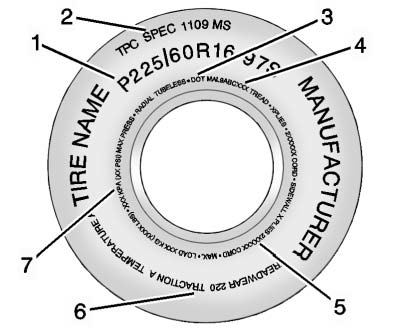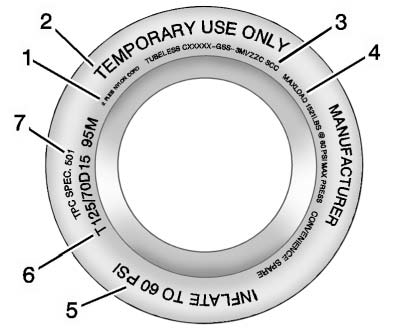Chevrolet Cruze Owners Manual: Tire Sidewall Labeling
Useful information about a tire is molded into its sidewall. The examples show a typical passenger vehicle tire and a compact spare tire sidewall.

Passenger (P-Metric) Tire Example
(1) Tire Size:
The tire size is a combination of letters and numbers used to define a particular tire's width, height, aspect ratio, construction type, and service description. See the “Tire Size” illustration later in this section.
(2) TPC Spec (Tire Performance Criteria Specification):
Original equipment tires designed to GM's specific tire performance criteria have a TPC specification code molded onto the sidewall.
GM's TPC specifications meet or exceed all federal safety guidelines.
(3) DOT (Department of Transportation):
The Department of Transportation (DOT) code indicates that the tire is in compliance with the U.S. Department of Transportation Motor Vehicle Safety Standards.
DOT Tire Date of Manufacture: The last four digits of the TIN indicate the tire manufactured date. The first two digits represent the week (01– 52) and the last two digits, the year. For example, the third week of the year 2010 would have a four-digit DOT date of 0310.
(4) Tire Identification Number (TIN):
The letters and numbers following the DOT (Department of Transportation) code are the Tire Identification Number (TIN).
The TIN shows the manufacturer and plant code, tire size, and date the tire was manufactured. The TIN is molded onto both sides of the tire, although only one side may have the date of manufacture.
(5) Tire Ply Material:
The type of cord and number of plies in the sidewall and under the tread.
(6) Uniform Tire Quality Grading (UTQG):
Tire manufacturers are required to grade tires based on three performance factors: treadwear, traction, and temperature resistance.
(7) Maximum Cold Inflation Load Limit:
Maximum load that can be carried and the maximum pressure needed to support that load.

Compact Spare Tire Example
(1) Tire Ply Material:
The type of cord and number of plies in the sidewall and under the tread.
(2) Temporary Use Only:
The compact spare tire or temporary use tire should not be driven at speeds over 80 km/h (50 mph).
The compact spare tire is for emergency use when a regular road tire has lost air and gone flat. If the vehicle has a compact spare tire, see Compact Spare Tire on page 10‑77 and If a Tire Goes Flat on page 10‑59.
(3) Tire Identification Number (TIN):
The letters and numbers following the DOT (Department of Transportation) code are the Tire Identification Number (TIN).
The TIN shows the manufacturer and plant code, tire size, and date the tire was manufactured. The TIN is molded onto both sides of the tire, although only one side may have the date of manufacture.
(4) Maximum Cold Inflation Load Limit:
Maximum load that can be carried and the maximum pressure needed to support that load.
(5) Tire Inflation:
The temporary use tire or compact spare tire should be inflated to 420 kPa (60 psi).
(6) Tire Size:
A combination of letters and numbers define a tire's width, height, aspect ratio, construction type, and service description. The letter T as the first character in the tire size means the tire is for temporary use only.
(7) TPC Spec (Tire Performance Criteria Specification):
Original equipment tires designed to GM's specific tire performance criteria have a TPC specification code molded onto the sidewall.
GM's TPC specifications meet or exceed all federal safety guidelines.
 Summer Tires
Summer Tires
This vehicle may come with high performance summer tires. These tires have a
special tread and compound that are optimized for maximum dry and wet road performance.
This special tread and compound ...
 Tire Designations
Tire Designations
Tire Size
The following is an example of a typical passenger vehicle tire size.
(1) Passenger (P-Metric) Tire: The United States version of a metric tire
sizing system. The letter P as the first ...
Other materials:
Radio Data System (RDS)
RDS features are available for use only on FM stations that broadcast RDS information.
With RDS, the radio can:
• Seek to stations broadcasting the selected type of programming.
• Receive announcements concerning local and national emergencies.
• Display messages from radio stations.
Thi ...
Removal Procedure
Raise and support the vehicle. Refer to Lifting and Jacking the Vehicle.
Remove the brake rotor. Refer to Front Brake Rotor Replacement.
Remove the wheel speed sensor screw (2).
Remove the wheel speed sensor (1) from the steering knuckle.
Remove the wheel drive shaft from the fron ...
Rear Suspension
Specifications
Rear Suspension Components
Rear Shock Absorber Upper Mount
Rear Shock Absorber Upper Mount
Rear Shock Absorber Upper Mount
Rear Shock Absorber Upper Mount
Shock Absorber Assembly
Upper Dumping Ring
Rear Spring
Lower Dumping Ring
Rear Axle Bushing
Rear Ax ...
